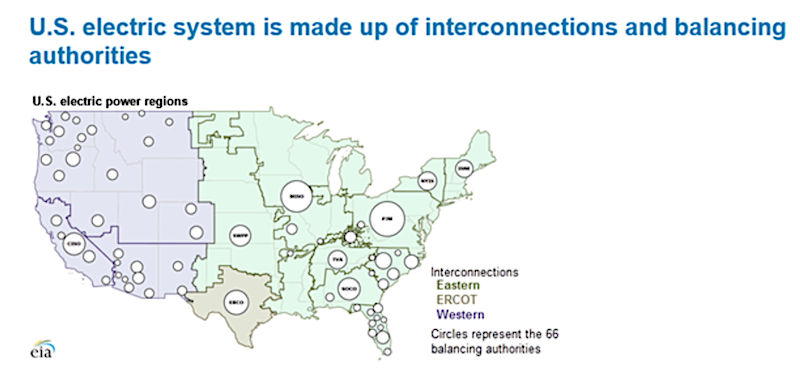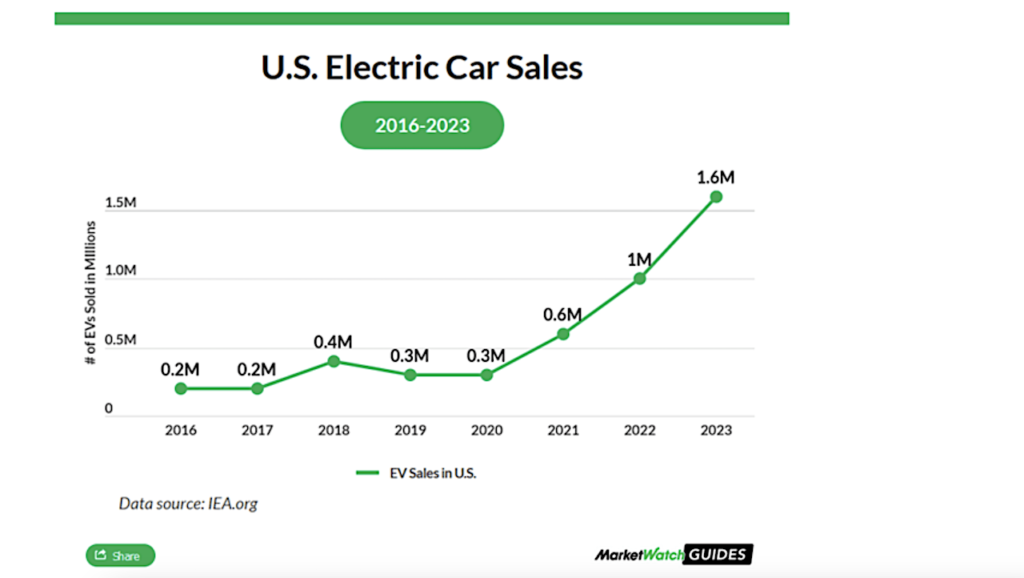Some winners from the artificial intelligence (AI) and electric vehicles (EV) boom are easy to spot.
For instance, shares of Nvidia, Microsoft, Tesla, and other companies have posted significant gains, anticipating a surge in future revenue and profits.
The development of AI data centers and the continued growth of EVs will benefit industries and companies that are not yet as closely followed. As a result, the stock prices of some companies in these industries may have some catching up with those mentioned above.
This article focuses on the potential beneficiaries of the significant investment necessary to upgrade, expand, and run the nation’s power grid to accommodate AI data centers and the continued growth of electric vehicles. We follow up with Parts Two and Three to drill down to the industries and companies that may benefit most from the coming changes to the power grid.
To help appreciate the power grid expansion needed to run AI data centers, consider the following comment from Lal Karsanbhai, CEO of Emerson Electric.
AI data center racks consume significantly more power than traditional data centers with a search on ChatGPT consuming 6 to 10 times the power of a traditional search on Google.
A Lesson From Levi Strauss
Before revealing the lesser-appreciated beneficiaries of the artificial intelligence (AI) and electric vehicles (EV) booms, we share the genius of Levi Strauss. Born in 1829, Levi Strauss opened a branch of his family’s dry goods business in San Francisco during the gold rush. Gold miners were flocking to the region and stocking up on goods. They needed items like pickaxes, food, and clothing to help them in their quest to make fortunes.
In 1873, Levi invented a more durable brand of pants for miners, made of denim and using metal rivets. Today, these pants go by the name of blue jeans. Levi smartly realized that handsome returns could be had by supplying the miners. Therefore, one needn’t risk their fortunes or life and limb to profit from a game of chance like gold mining.
Levi profited dearly from the gold rush. But, unlike most gold miners, his profits were consistent and lasting. His ingenuity still pays big dividends to his descendants.
Let’s uncover the next Levi Strauss of the AI/EV rush. These not-so-obvious companies serve as critical lynchpins to maximize AI and EVs’ value via the power grid.
Status of the Power Grid
We start with a brief summary of the power grid from the EIA.
Electricity generated at power plants moves through a complex network of electricity substations, power lines, and distribution transformers before it reaches customers. In the United States, the power system consists of more than 7,300 power plants, nearly 160,000 miles of high-voltage power lines, and millions of low-voltage power lines and distribution transformers, which connect 145 million customers.
Local electricity grids are interconnected to form larger networks for reliability and commercial purposes. At the highest level, the United States power system in the Lower 48 states is made up of three main interconnections, which operate largely independently from each other with limited transfers of power between them.

The EIA estimates the US generated 4,178 billion kilowatt-hours (kWH) of electricity in 2023. Fossil fuels account for 60% of the total, with natural gas and coal being the two largest. Nuclear and renewable sources account for most of the remaining 40%.
In the future, not only will the power grid need to be modernized and expanded to supply more power, but the political and public pressure to make it environmentally cleaner will likely be more powerful. The EIA expects global power-generating capacity to increase by 30% to 76% by 2050.
Given the size of the US economy and the number of US-domiciled companies leading the global AI and EV industries, a good portion of the increased global power needs will likely occur on US soil.
Starting From Behind
As many of you can attest, the power grid increasingly exhibits outages due to extreme temperatures. The problem is multifaceted. As renewable energy resources become a larger share of the electric generation resource base, the system grows inherently more sensitive to extreme weather events. Traditional resources that are ill-prepared for new extremes are also showing vulnerabilities. Consequently, expanding the power grid requires utility companies to also invest in significant upgrades. For example, among these upgrades are new federal regulations requiring additional cold weather preparations for electric generators.
Per the WSJ–
A report last year by the American Society of Civil Engineers found that 70% of transmission and distribution lines are well into the second half of their expected 50-year lifespans. Utilities across the country are ramping up spending on line maintenance and upgrades. Still, the ASCE report anticipates that by 2029, the US will face a gap of about $200 billion in funding to strengthen the grid and meet renewable energy goals.
The article estimates that the investment shortfall could accumulate to $338 billion by 2039. That estimate will, unfortunately, prove to be too low. The article was written in February 2022, before the massive energy demands for AI data centers were fully appreciated.
The bottom line is that utility companies, other power distributors, and municipalities must invest hundreds of billions of dollars over the next decade to modernize and expand our power grids.
The Impact of EVs and AI Data Centers on the Power Grid
EVs
Assuming the acceptance growth rate of EVs continues, the electricity demand will increase substantially. The EIA estimates that US EV sales could surpass 3.5 million in 2025. That number could rise to over 8 million by 2030. Furthermore, if improvements to EV batteries to boost the driving range per charge and the number of charging stations increase rapidly, the EIA 2030 estimate could fall well short of reality.
On a side note, as we wrote in Is Toyota The Next Tesla, solid-state batteries, expected to be produced by Toyota as early as 2027, could be a game changer that dramatically boosts demand for EVs.
For context, EV sales increased from 1 million in 2022 to 1.6 million in 2023 (per MarketWatch). Edmunds estimates there are about 3.3 million EVs in the US, accounting for only 1% of the total vehicles.

Estimates suggest that if EVs were to replace a significant portion of internal combustion engine vehicles, electricity demand could increase by 20% to 40% over the next few decades. Based on the quote below, that may be a gross underestimation.
“PG&E expects system demand to increase up to 70% over the next two decades as more EVs are added.” – Utility Dive
Not only is more electricity needed, but the power grid must also be upgraded to account for the timing of EV-related energy demands. EV charging, mainly if done simultaneously during peak hours, like early evenings, can lead to higher than current peak loads.
AI Data Centers
AI data centers alone are expected to add about 323 terawatt hours of electricity demand in the US by 2030, according to Wells Fargo. The forecast power demand from AI alone is seven times greater than New York City’s current annual electricity consumption of 48 terawatt hours. Goldman Sachs projects that data centers will represent 8% of total US electricity consumption by the end of the decade. – CNBC
From the same article comes the following quote from Robert Blue, CEO of Dominion Energy
“Economic growth, electrification, accelerating data center expansion are driving the most significant demand growth in our company’s history, and they show no signs of abating,”
Dominion Energy projects that demand from data centers in Virginia will more than double by 2030. Northern Virginia hosts the largest number of data centers in the country.
While researching this article, we came across many forecasts and comments like the ones above. The bottom line is that AI data center growth will be explosive. Consequently, the power demand will grow substantially.
Summary
AI and EVs can potentially increase the nation’s productivity growth, which would go a long way toward boosting economic growth. However, with the potential benefits come significant investments. Some companies have already made massive investments in those industries. Others, like those involving the power grid, are just getting started.
We will follow this article with two more focusing on the industries and some stocks best situated to benefit from the modernization and expansion of the power grid and those that can help the utilities meet environmental goals.
Twitter: @michaellebowitz
The author or his firm may have positions in mentioned securities at the time of publication. Any opinions expressed herein are solely those of the author, and do not in any way represent the views or opinions of any other person or entity.








